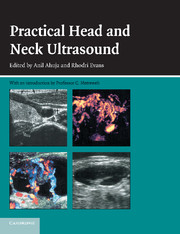Book contents
- Frontmatter
- Contents
- Contributors
- Introduction
- Acknowledgement
- CHAPTER 1 Anatomy and Technique
- CHAPTER 2 Salivary Glands
- CHAPTER 3 The Thyroid and Parathyroids
- CHAPTER 4 Lymph Nodes
- CHAPTER 5 Lumps and Bumps in the Head and Neck
- CHAPTER 6 The Larynx
- CHAPTER 7 What the Surgeon Needs to Know, and Why
- CHAPTER 8 Fine-Needle Aspiration or Core Biopsy?
- CHAPTER 9 Carotid and Vertebral Ultrasonography
- Index
CHAPTER 7 - What the Surgeon Needs to Know, and Why
- Frontmatter
- Contents
- Contributors
- Introduction
- Acknowledgement
- CHAPTER 1 Anatomy and Technique
- CHAPTER 2 Salivary Glands
- CHAPTER 3 The Thyroid and Parathyroids
- CHAPTER 4 Lymph Nodes
- CHAPTER 5 Lumps and Bumps in the Head and Neck
- CHAPTER 6 The Larynx
- CHAPTER 7 What the Surgeon Needs to Know, and Why
- CHAPTER 8 Fine-Needle Aspiration or Core Biopsy?
- CHAPTER 9 Carotid and Vertebral Ultrasonography
- Index
Summary
Introduction
A surgeon working in the head and neck area is frequently asked to see lumps or swellings presenting in that region. In the past, the diagnosis depended on an accurate history followed by a thorough clinical examination. On the basis of these, the surgeon would then select those investigations which would confirm or refute the clinical diagnosis. The surgical management of the case was thus determined. An investigation would only be justified if the findings would influence the decision on the type of treatment to be prescribed.
Although sophisticated imaging techniques now exist, the history and clinical examination still remain the most important means of diagnosing neck and facial ‘lumps’. In this chapter, we outline what the surgeon would ideally like to know about a lump before any treatment is undertaken. We focus mainly on lumps in the neck as this is the area where there is the greatest controversy. In particular, we will stress the importance of accurate assessment of the regional lymph nodes in head and neck cancer, as this largely determines the surgical management of the case and the outcome for the patient.
The clinical characteristics of a lump
In the past, when imaging procedures were unsophisticated, surgeons would pride themselves on their ability to elicit subtle clinical signs. The ability to do this depended on a long clinical apprenticeship and skilled clinical teachers. Invariably, the ability of surgeons to come to the correct diagnosis, based on a clinical examination alone, varied considerably.
- Type
- Chapter
- Information
- Practical Head and Neck Ultrasound , pp. 119 - 128Publisher: Cambridge University PressPrint publication year: 2000

